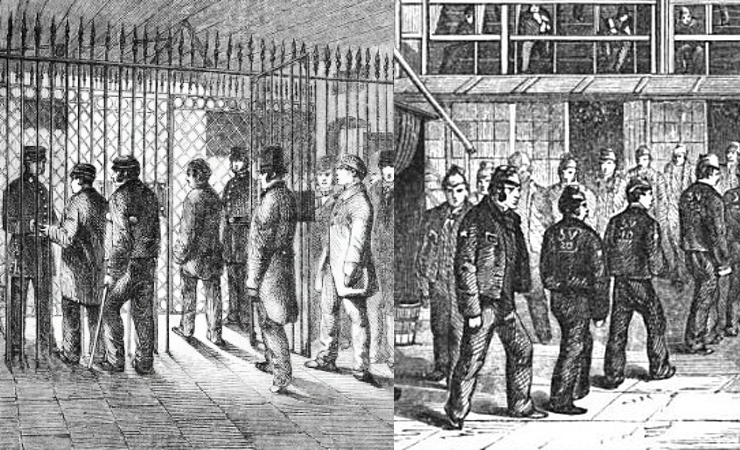Prison uniforms are more than just garments; they serve as powerful symbols of crime, punishment, and social control. Over the centuries, prison attire has evolved in response to changing penal philosophies, practical necessities, and even broader fashion trends. From the bold stripes of the 19th century to today’s standardized jumpsuits, the evolution of prison clothing reflects not only shifts in the justice system but also the intersection of dress, identity, and authority.
Early Prison Attire: Marking the Criminal

Before standardized uniforms, prisoners typically wore their own clothing, often in a deteriorated state. This lack of regulation was common in the 18th and early 19th centuries when prisons were less centralized, and incarceration was not the primary form of punishment—executions, corporal punishment, and exile were far more common.
When prison systems became more structured in the 19th century, authorities sought to impose visual markers of punishment. Clothing became one of the most effective tools for distinguishing prisoners from the general population. The earliest prison uniforms were designed not only for practicality but also as a means of public shaming. These garments were intentionally coarse, uncomfortable, and demeaning, reinforcing the loss of individual identity and social status.
The Striped Era: Visibility, Humiliation, and Institutional Control

By the mid-19th century, the black-and-white striped uniform became the standard prison attire in many Western countries, particularly in the United States and parts of Europe. These stripes were more than just a distinctive pattern; they had deep symbolic and practical implications:
- Visual Marking: The alternating stripes ensured that prisoners were instantly recognizable, making escape more difficult.
- Moral Branding: The stark contrast between black and white visually reinforced the binary perception of good and evil, guilt and innocence.
- Humiliation and Social Exclusion: Striped uniforms made reintegration into society more challenging, as former inmates often carried the stigma of their prison attire long after their release.

Interestingly, this use of stripes as a punitive symbol had historical precedents. In medieval Europe, stripes were often associated with outcasts—executioners, jesters, lepers, and prostitutes were sometimes required to wear striped garments as signs of their marginal status. This connotation carried into prison uniforms, reinforcing the notion that criminals existed outside the moral and social order.

However, as attitudes toward punishment shifted in the early 20th century, criticism grew against striped uniforms. Reformers argued that such highly conspicuous attire hindered rehabilitation by permanently marking individuals as criminals. By the 1920s and 1930s, many prison systems began replacing stripes with more subdued, utilitarian clothing.
The Transition to Workwear: Khaki, Denim, and Practicality

The early-to-mid 20th century saw a movement toward prison uniforms inspired by industrial and military workwear. Many institutions introduced khaki or denim uniforms, which were:
- Less Stigmatizing: Earth tones and solid colors did not carry the same overt associations with crime as stripes.
- More Durable and Functional: Heavy-duty fabrics like denim, often paired with simple button-up shirts, mirrored the attire of factory and field workers.
- Aligned with Penal Labor: Many prisons emphasized work as a means of rehabilitation, and inmates were often dressed in garments similar to those worn by laborers outside prison walls.

This era also marked the introduction of gendered prison clothing—while men were typically assigned workwear-style uniforms, women’s prison attire often consisted of plain dresses or blouses and skirts, reflecting broader gender norms of the time. These garments were designed to strip inmates of personal expression while maintaining a certain level of social conformity.
The Rise of the Orange Jumpsuit: A Symbol of Modern Incarceration

By the late 20th century, the orange jumpsuit became the dominant prison uniform, particularly in the United States. While many institutions still use khaki, navy, or gray, the bright orange jumpsuit has become a near-universal symbol of incarceration.
Why Orange?

- High Visibility: Bright orange is easy to spot, making it harder for inmates to escape undetected.
- Cost-Effectiveness: One-piece jumpsuits are simpler and cheaper to produce than multi-piece uniforms.
- Practicality: Jumpsuits eliminate buttons, belts, and other elements that could be used for self-harm or as weapons.

However, the orange jumpsuit has also sparked controversy. Unlike older prison uniforms, which evolved from workwear, the modern jumpsuit lacks any resemblance to mainstream fashion, making it an immediate visual marker of incarceration. Additionally, as prison populations have grown—particularly in the United States—critics argue that the jumpsuit has contributed to the mass criminalization of marginalized communities, reinforcing negative stereotypes.
Prison Uniforms and Fashion: An Unexpected Influence

Despite their association with punishment, prison uniforms have made a surprising impact on mainstream fashion:
- Stripes: The association of stripes with punishment faded in the 20th century, allowing designers to reclaim the pattern in high fashion. Stripes are now a staple in everything from casualwear to haute couture.
- Workwear Aesthetics: The denim and khaki phase of prison attire paralleled the rise of workwear as a fashion statement. Today, many brands incorporate prison-inspired work jackets, chore coats, and rugged denim into their collections.
- Hip-Hop and Streetwear: The baggy silhouette of prison uniforms—often due to inmates receiving oversized clothing—was embraced by hip-hop culture in the 1990s. Loose-fitting jeans, jumpsuits, and even prison-issued shoes (such as slip-on canvas sneakers) became integral to urban fashion.
Some designers have even drawn direct inspiration from incarceration. For example, orange jumpsuits have appeared in fashion collections, often as a statement on the justice system or societal perceptions of crime and punishment. However, such trends often spark debate about the ethics of glamorizing imprisonment through fashion.
The Future of Prison Uniforms: Reform or Reinforcement?

As discussions about criminal justice reform grow, the future of prison uniforms remains uncertain. Some institutions are moving away from bright orange and adopting:
- Neutral-colored scrubs (navy, gray, or light blue) to reduce stigma.
- More personalized clothing policies that allow inmates to wear their own clothes in certain cases.
- Biodegradable or sustainable prison uniforms, reflecting environmental concerns.
In some European countries, prison uniforms have been largely phased out, with inmates wearing plain, practical clothing similar to that of civilians. The idea is that removing the visual marker of incarceration may aid in rehabilitation and reintegration.



